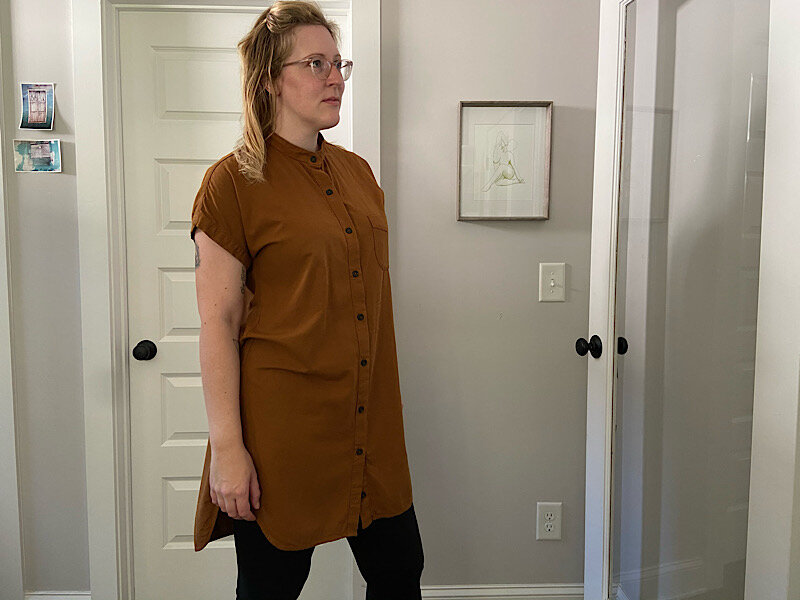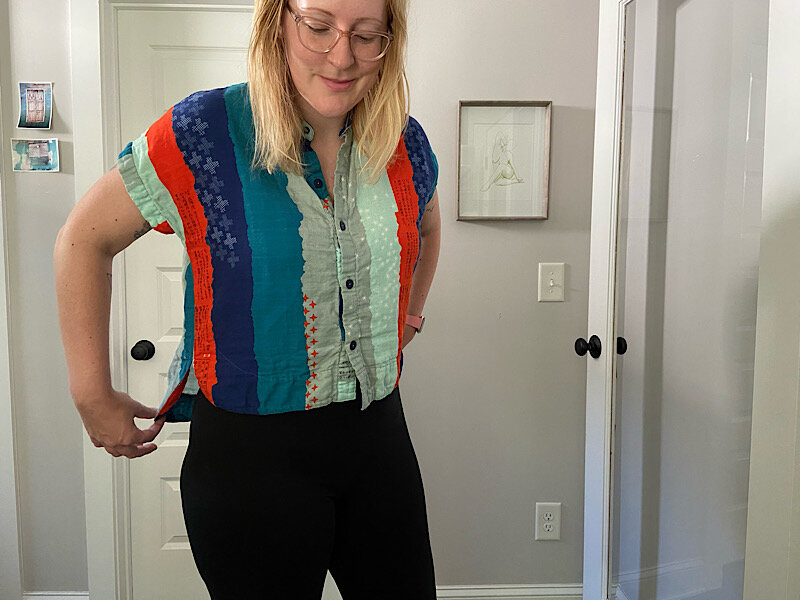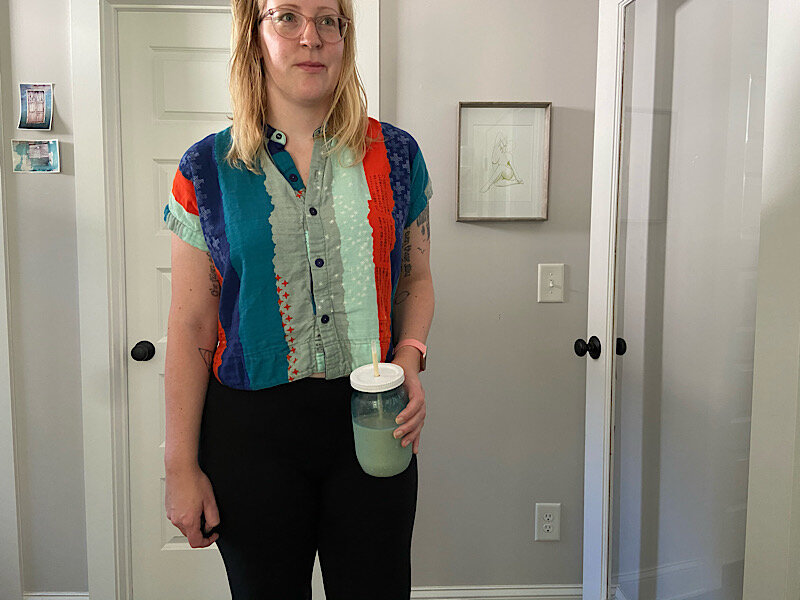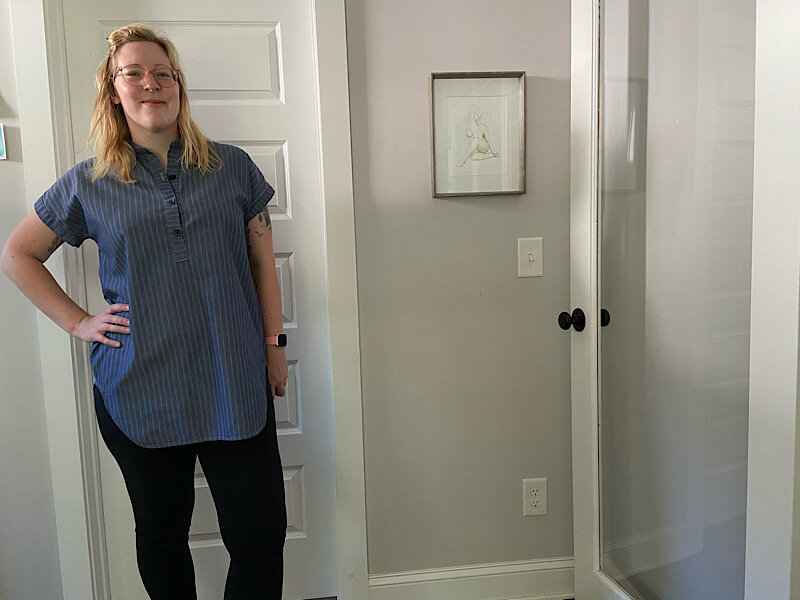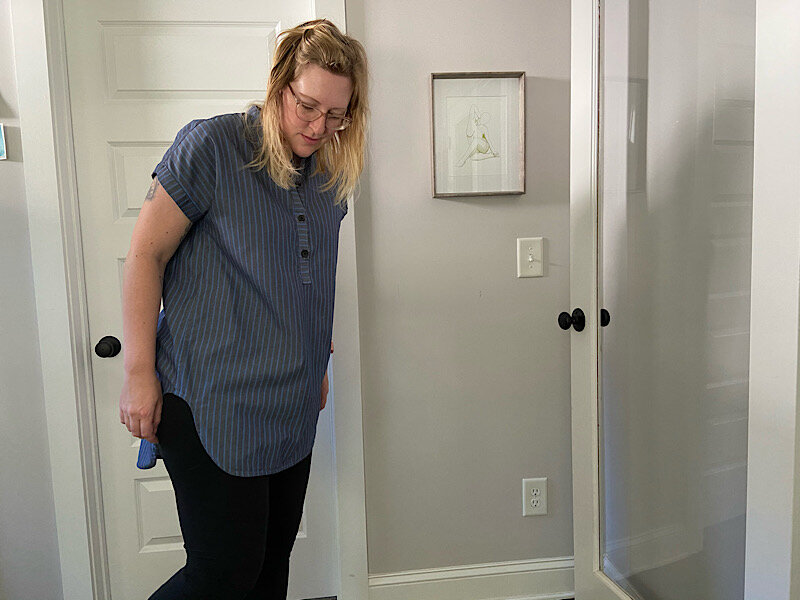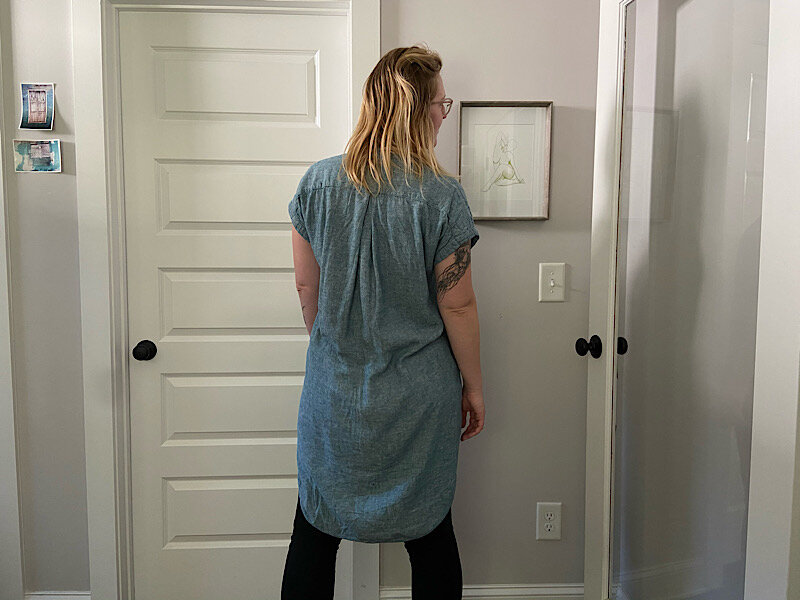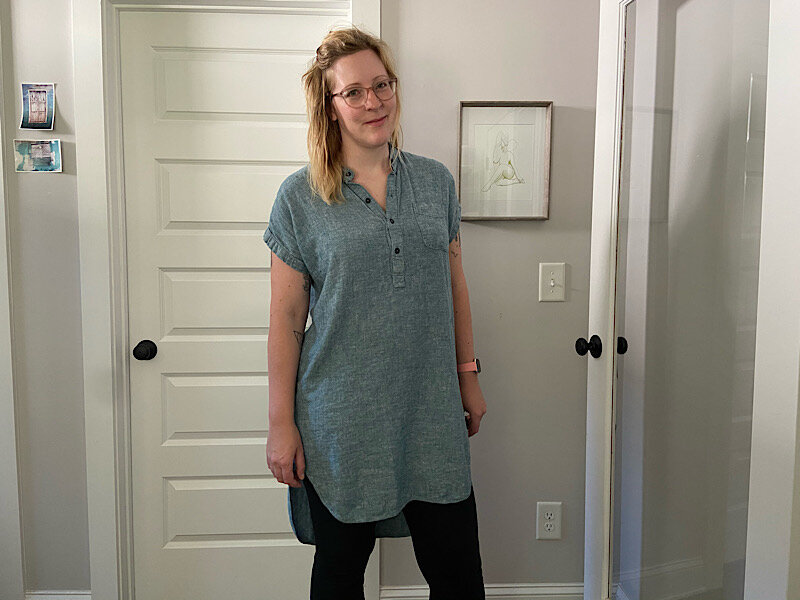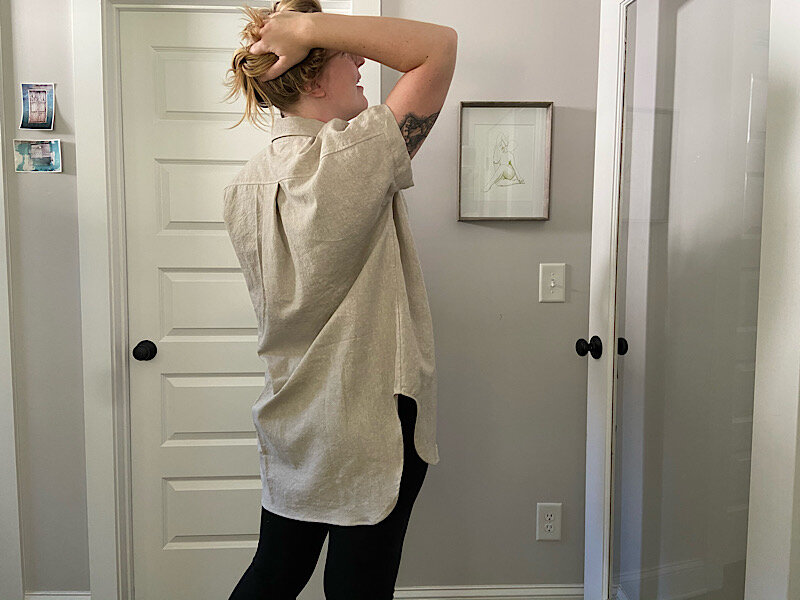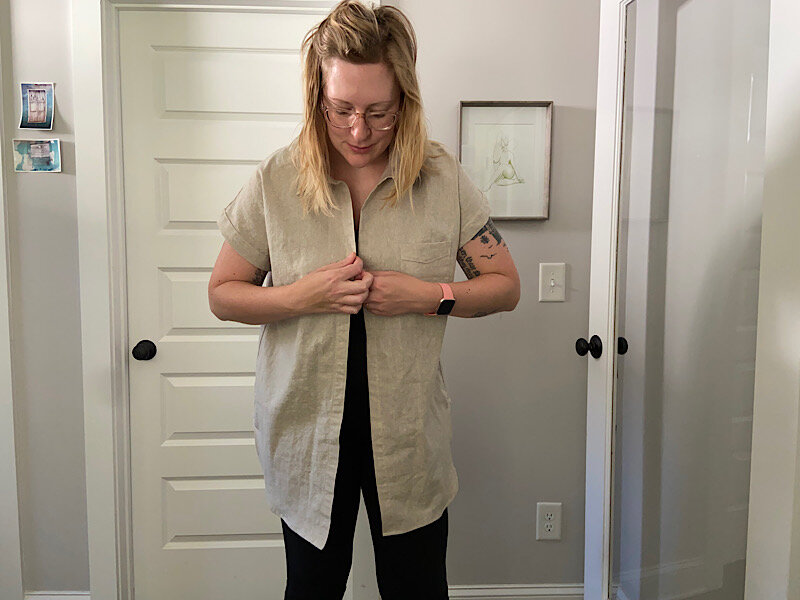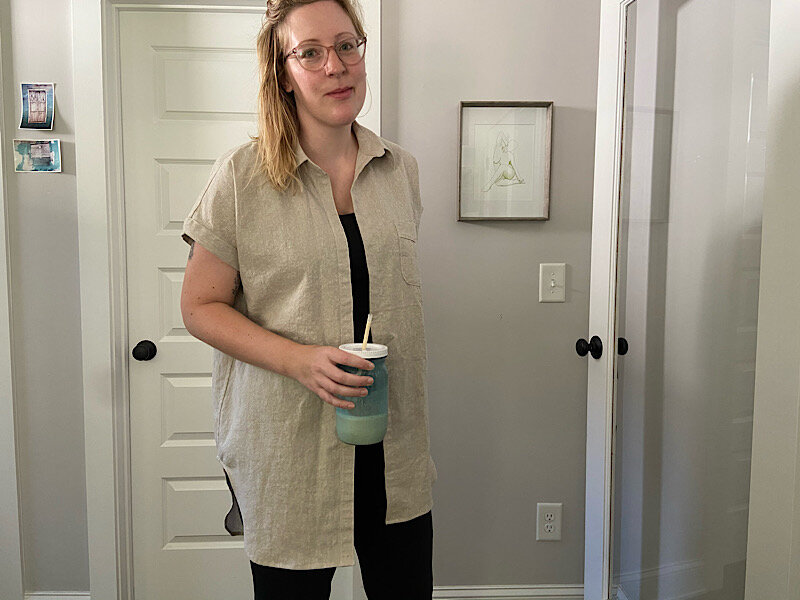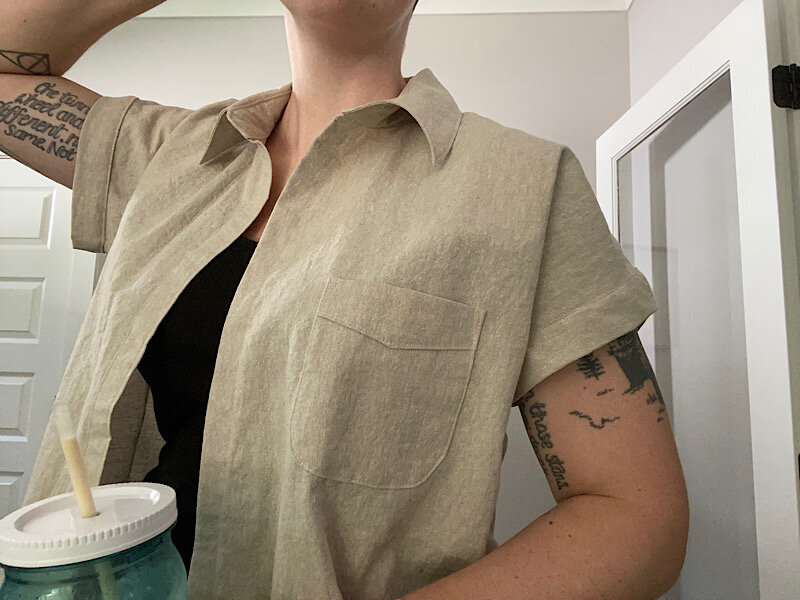So many ways to Kalle Shirtdress
The Kalle Shirtdress
I’m a few years into my apparel-making adventures, and at the start I would never have thought a collared shirt was something I would even try, let alone enjoy making. Then, a friend commissioned me to make him a men’s dress shirt, and a whole lot of things clicked. First, the scary idea of buttons and buttonholes; more than that, the fussy interior details of flat-felled seams; and most of all, the terrifying concept of a two-piece collar - how do you even make something so complex?!
Once I made the dress shirt, a lot of these fears dissipated. Not only could I do flat-fell seams, I loved them! What a nice, if slightly more time-consuming, way to finish the interior seams of clothing. (For those non-sewists reading, a flat-felled seam is a way to finish a garment seam on the inside, so that all of the raw edges are encased in upon themselves. Check any of your own dress shirts to see the double-stitched seam I’m talking on about!) This is the opposite of fast fashion, and we are making garments to last, so why not take the time to flat fell some seams? I went through a brief but intense period of finishing all my dress seams this way, until I acquired a friend’s serger.
My most recent Kalle, maybe my favorite yet. Fabric is Robert Kaufman Essex Linen in Natural. Doesn’t have buttons yet, but honestly not missing them so far.
Upon seeing how fun and not overly complex these shirt-making techniques were, I knew I had to sew the Kalle Shirtdress, a pattern by Closet Case Patterns. My best advice if you’re thinking about making any garment yourself is to follow the hashtag for it on Instagram. #Kalleshirtdress has thousands of variations for you to gather endless inspiration for your own versions.
I’ve now made 6 versions, my most recent perhaps being my favorite so far. I wear every dang version of this garment frequently except for my shirt version - I think that’s because I used fabric that was free-to-me and that I love, but turns out I don’t wear flashly prints in my regular routine (and somehow didn’t remember that fact about myself). But the tunic-length and dress-length Kalles get frequent wear, especially in the warmer summer months.
Dress-length Kalle with band collar. I love wearing Kalle buttoned all the way up. This ochre version is in raw silk noil from Fancy Tiger Crafts.
A chambray dress-length Kalle with the popover placket. Fabric used is Robert Kaufman Essex Brussels Linen from Stash Fabrics. I love love love this version in summer, and have been wearing it frequently in quarantine!
Modifications:
Each time, I’ve played around with inches added to the garment. It’s designed for 5’6” and I am 5’10” so I have already added at least 3” to each version.
I cut the size 14 in each version, View A (shirt), View B (tunic), View C (dress). The most recent version I’ve graded the shoulders to the size 16 to give myself a little extra room in the shoulders; this worked very well for me and I will do that in any future versions.
The crazy wonderful thing about this pattern is that YOU MAKE MANY SO MANY MODS to fit your style. Some folks don’t like the high-low hemline and just cut it even. Some have done maxi-dress length. I’m obsessed with the band collar (“collarless” look) and so five of my six versions have that instead of the traditional collar. You can make it with the pop-over placket (buttons only to about your waist) or the full-length placket. It also has an option for a hidden placket (which I did once and found too finicky to bother with ever again).
Here’s the cropped shirt version I made for my mom in lovely lightweight voile. This version used the hidden placket, which was totally confusing and required internet support. I’ve not tried that version again! She loves the result, though!
Critiques on the pattern:
Obviously I love the fit and the style of this pattern, or I wouldn’t have made six of them (and counting). I highly recommend owning this pattern if you love wearing dresses and you love a menswear vibe, as you’ll return to it often. Overall it gets a very solid A grade from me.
The Kalle is designed intentionally as very roomy cut and as I noted above, the main thing I’ve had to adjust for from the Size 14 I cut is for my shoulders. There is no shaping in the body, so it is very forgiving. I am more often a 16-18-20 in traditional patterns based on my body measurements. Check out the many ways to style this dress other makers have worn, especially with a belt, if you want it a bit more shapely.
The labeling of the yoke “top” and “bottom” in the instructions always trips me up, despite making this many times. I feel labeling them “top” and “bottom” is super unclear, and I’ve had to erase my own notes when I assumed wrong, as well as seam rip and redo several times to do this. Why not label them Outer and Inner, so it’s VERY intuitive which one will end up on the OUTSIDE and which on the INSIDE of the garment? (This detail won’t matter if you are using the same fabric on both sides, but I love to have a little interior FUN fabric, and this design choice has given me pains when I get it wrong and have to rip it out and do it over!)
The instructions for installing the sleeve cuffs are a little unclear if you’ve never done that kind of cuff before. Fortunately the designer did a sewalong where she gives a much clearer tutorial on how to do that on her blog! Bookmark it for your own use.
Happy sewing!
I’ve included notes on each variation for your reference below, I hope you find it helpful if you decide to make your own Kalle. Share with me your versions and of course, any questions as you’re going along if you get stuck or need a second opinion!
In the above grid:
Dress length Kalle in ochre (1)
Featuring band collar, full placket, and 3” added to front and back of the dress-length version. Made in raw silk noil purchased from Fancy Tiger Crafts.
Cropped stripe print Kalle (2)
Featuring band collar, full placket, and 3” added to the shirt-length version. Made in colorful printed double gauze that I got at a fabric swap.
Blue striped tunic Kalle (3)
Specs are band collar, popover placket, tunic length. Added 3” to tunic length pattern. Popover placket is super fun, don’t be afraid of it! Wonderful to wear too, and not as many buttons to attach! Fabric was given to me by a friend who purchased it at a craft store for an abandoned home improvement project. This was my first Kalle so I used the fabric as a trial run!
Chambray Kalle (4)
Dress-length version with band collar and popover placket. This is my favorite summer version. I accidentally made the back longer and the front shorter, so it’s too short to wear without leggings but let’s be real, I’m often wearing leggings anyway. I like the length of this one for summer casual wearing, since it’s more like a tunic length in front due to my mistake. The Brussels washed linen in super soft, perfect summer chambray staple dress. Robert Kaufman Brussels washer linen from Stash Fabrics. The washer linen is some of the softest stuff, especially great for summer apparel!
Natural Linen tunic Kalle (5)
Two-piece collar, tunic length (3” added as my usual), full placket. This is my most recent version and the natural linen is making it possibly my favorite tossed over all black anything underneath. It’s tunic length and my FIRST Kalle with the full two-piece collar! (I love the band collar if you hadn’t guessed that.) I also graded the shoulders to give me a little more room in the shoulders, closer to the size 16, and love the results. Will be doing that on all Kalles moving forward. Fabric is Robert Kaufman Essex Linen in Natural.






